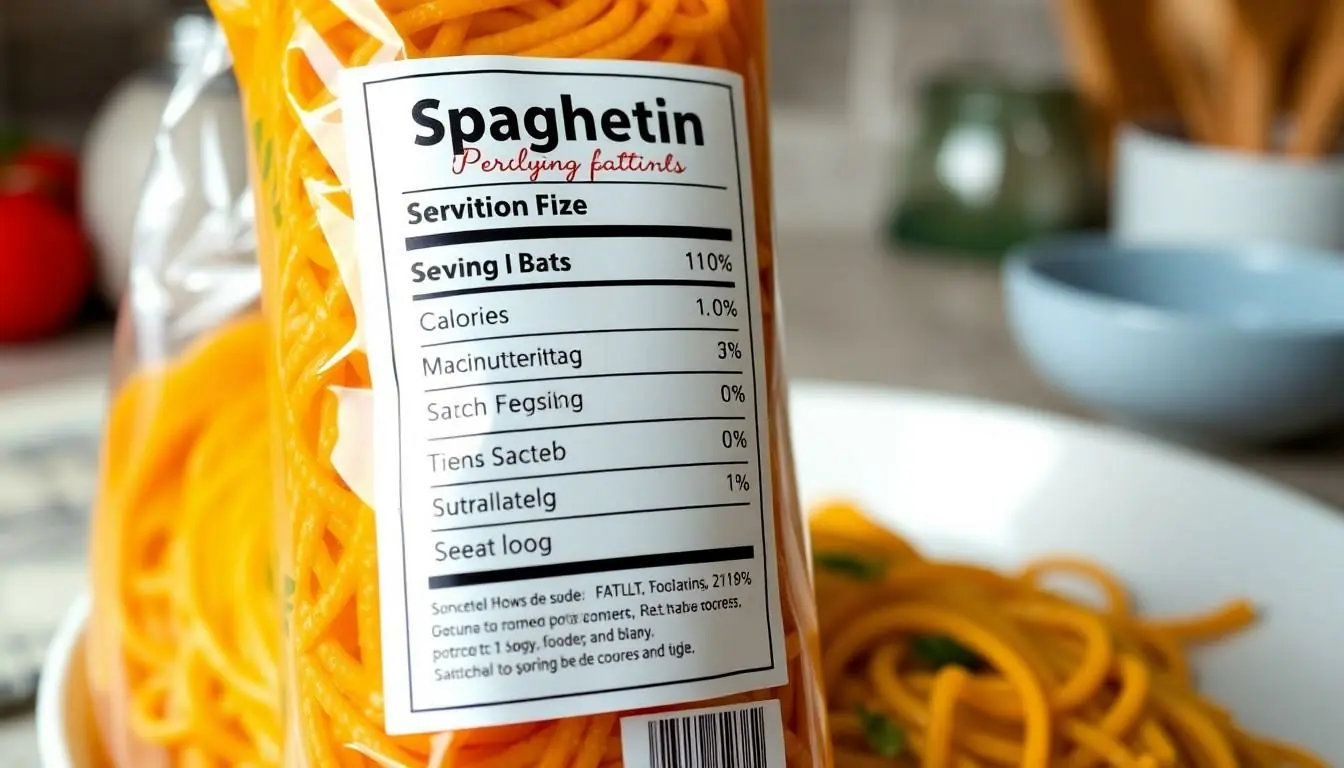When it comes to comfort food, spaghetti reigns supreme. It’s the ultimate culinary hug, twirling its way into hearts and bellies alike. But before diving into that heaping plate, have you ever taken a peek at the spaghetti nutrition label? Spoiler alert: it’s not just about carbs and sauce.
Understanding what’s in that delightful dish can turn a guilty pleasure into a guilt-free indulgence. With a little knowledge, one can savor every bite while keeping health goals in check. So, grab your fork and let’s unravel the mysteries of spaghetti nutrition labels. Who knew pasta could be both delicious and informative?
Table of Contents
ToggleOverview Of Spaghetti Nutrition Label
Understanding the nutritional content of spaghetti provides insight into its health benefits and downsides. This knowledge aids consumers in making informed dietary choices.
Key Nutritional Components
Spaghetti primarily contains carbohydrates, which serve as a primary energy source. Protein content varies but usually falls between 6 to 8 grams per serving, contributing to muscle repair and growth. Fiber plays a significant role, with whole grain variations offering up to 3 grams per serving, promoting digestive health. Some spaghetti includes essential vitamins and minerals, such as iron and B vitamins, which support various bodily functions. Fats are minimal, generally amounting to less than 1 gram per serving, making it a low-fat food option.
Variations In Nutrition Labels
Nutrition labels differ across spaghetti types, including traditional, whole wheat, and gluten-free options. Whole wheat spaghetti often displays higher fiber content, sometimes exceeding 6 grams per serving. Gluten-free varieties present alternative composition, frequently relying on rice or corn, with differing nutrient profiles. Additionally, enriched spaghetti labels indicate added vitamins and minerals, enhancing nutritional value. It’s essential to review serving sizes on each package, as portions can impact overall nutrient intake. Tracking these variations helps consumers select products that align with their health goals.
Reading The Spaghetti Nutrition Label

Understanding the nutrition label on spaghetti is essential for making informed choices. Focusing on serving sizes, calories, and macronutrient content helps maintain a balanced diet.
Serving Size
Serving sizes vary across brands and types of spaghetti. Typically, one serving amounts to about 2 ounces of dry pasta. This measurement translates to approximately 1 cup of cooked spaghetti. Reading the label ensures accurate portion control, allowing for better calorie and nutrient management. Recognizing serving sizes prevents unintentional overconsumption, aiding in weight management and overall health.
Calories And Macronutrients
Caloric content usually fluctuates by spaghetti type. Traditional spaghetti generally contains around 200 calories per serving. Each serving also provides 6 to 8 grams of protein, contributing to daily protein needs. Carbohydrates dominate, with roughly 40 grams per serving, fueling energy levels. Fiber content ranges between 2 to 3 grams, varying with whole grain options, which often provide more. Always check the nutrition label for specific details, especially when comparing different spaghetti varieties.
Health Benefits Of Spaghetti
Spaghetti offers several health benefits that contribute to a balanced diet. Understanding its nutritional profile helps in making healthier choices.
Fiber Content
Fiber content plays a crucial role in digestive health. Spaghetti, especially whole wheat varieties, contains higher levels of fiber, often ranging from 5 to 7 grams per serving. Consuming adequate fiber helps promote regular bowel movements and aids in maintaining a healthy weight. A diet rich in fiber can also lower cholesterol levels and stabilize blood sugar. For those choosing refined spaghetti, fiber content measures around 2 to 3 grams per serving, providing some benefits but less than whole grain options. Incorporating fiber-rich spaghetti contributes to overall well-being.
Source Of Energy
Spaghetti acts as a significant source of energy for many people. Carbohydrates in spaghetti, typically around 40 grams per serving, serve as the primary fuel for physical activity. After consumption, the body converts carbohydrates into glucose, supplying essential energy for daily tasks. Protein, found in spaghetti at levels of 6 to 8 grams per serving, also supports energy production and muscle repair. For athletes or active individuals, pairing spaghetti with protein-rich toppings enhances its capacity to energize. By integrating spaghetti into meals, energy levels can remain stable throughout the day.
Common Misconceptions
Understanding spaghetti’s nutritional profile helps dispel common misconceptions. Many people may think that whole wheat spaghetti lacks flavor compared to regular spaghetti. In reality, whole wheat options provide higher fiber content, ranging from 5 to 7 grams per serving. Regular spaghetti generally contains about 2 to 3 grams of fiber. Consumers often believe that both types have similar health benefits, but whole wheat varieties promote better digestive health due to their increased fiber levels.
Confusion also arises regarding gluten-free spaghetti. Some might assume these alternatives lack essential nutrients. However, gluten-free spaghetti options, such as those made from rice or corn, contain varying nutritional profiles. These options can provide similar caloric values to traditional spaghetti, roughly 200 calories per serving. Additionally, gluten-free variants can offer fiber levels akin to whole wheat spaghetti, depending on the ingredients used. It’s crucial to check nutrition labels for accurate comparisons.
Understanding spaghetti’s nutrition label empowers individuals to make informed dietary choices. By recognizing the differences in nutritional content among various types of spaghetti, it’s easier to incorporate this beloved comfort food into a balanced diet. Whether opting for traditional, whole wheat, or gluten-free varieties, each option offers unique benefits that can enhance overall health.
With a focus on serving sizes and nutrient profiles, spaghetti can be enjoyed guilt-free while supporting health goals. Embracing the nutritional aspects of spaghetti allows for a satisfying meal that fuels the body effectively. Ultimately, knowledge is key to enjoying spaghetti as part of a nutritious lifestyle.




